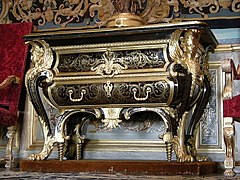Boulle work
Boulle work[1] (also known as buhl work) is a type of rich marquetry[2] process or inlay perfected by the French cabinetmaker André-Charles Boulle[3]
(1642–1732).
Although Boulle did not invent the technique, he was its greatest practitioner and gave his name to it. Boulle came from a well-known Protestant family of artists in France living primarily in Paris but also in Marseille.[5][6] The first recorded payment to Boulle by the crown, from 1669, specifies ouvrages de peinture, suggesting that he was originally a painter.[7] Boulle was awarded the title of master cabinetmaker around 1666; in 1672[8] he received the post of Premier ébéniste du Roi[9] and was admitted to a group of skilled artists maintained by Louis XIV, in the Louvre Palace. In 1672 Boulle received a warrant signed by the queen, giving him the added title of bronzier as well as Ebeniste du Roi. One of Boulle's greatest masterpieces is considered[by whom?] to be his decoration of the dauphin's private study, created between 1681 and 1683.[10] Boulle's masterpieces are now mostly in museums and have come to represent the wealth, luxury and finesse of the court of Louis XIV, the Sun King.
In 2016 a putative descendant of Boulle, Jean-Raymond Boulle, invented a Boulle work process of inlay using gem diamonds which is produced by AkzoNobel and has been used by Rolls-Royce.[11]
References
- ^ "Boulle Work". Boulle Vortal. Archived from the original on Oct 3, 2022.
- ^ "Masters of marquetry in the 17th century: Boulle". Khan Academy. Archived from the original on 2020-03-08. Retrieved 2017-11-28.
- Google Arts and Culture.
- ^ "Death of André-Charles Boulle". Mercure de France.
- ^ "André-Charles Boulle". "André Boulle, Ebeniste de Louis XIV" M. CHARLES ASSELINEAU 1872 P 11.
- ^ Jean-Pierre Samoyault, "André-Charles Boulle et sa famille: nouvelles recherches, nouveaux documents" Haute Etudes Medievales et Modernes, Nr 40, 1979, pp. 5, Librairie Droz, Genève.
- ^ "Biography of Boulle, André-Charles". Web Gallery of Art. Retrieved 2020-07-07.
- ^ One or more of the preceding sentences incorporates text from a publication now in the public domain: Penderel-Brodhurst, James (1911). "Boulle, André Charles". In Chisholm, Hugh (ed.). Encyclopædia Britannica. Vol. 4 (11th ed.). Cambridge University Press. pp. 321–323.
- ^ Dell 1992:187.
- ^ "André-Charles Boulle | French cabinetmaker". Encyclopedia Britannica. Retrieved 2020-07-07.
His masterpiece, however, was his decoration of the dauphin's private study with flooring in wood mosaic and extraordinarily detailed paneling and marquetry (1681–83; now destroyed).
- ^ Banks, Nargess (Mar 20, 2017). "Meet The World's First Diamond Car, The Rolls-Royce Ghost Elegance". Forbes. Retrieved 20 March 2017.
External links
- Veneer page at Encyclopædia Britannica




